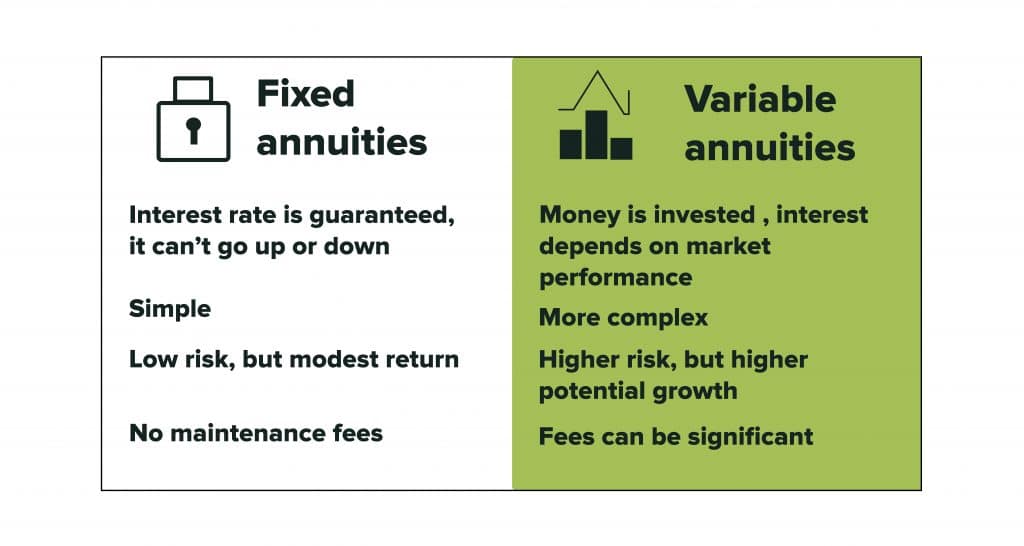All Categories
Featured
Table of Contents
Simply as with a taken care of annuity, the owner of a variable annuity pays an insurance coverage business a lump sum or collection of payments for the pledge of a series of future settlements in return. Yet as mentioned over, while a fixed annuity grows at a guaranteed, consistent price, a variable annuity grows at a variable price that depends upon the performance of the underlying financial investments, called sub-accounts.

During the accumulation phase, properties bought variable annuity sub-accounts grow on a tax-deferred basis and are tired just when the contract proprietor takes out those revenues from the account. After the accumulation stage comes the earnings phase. With time, variable annuity possessions ought to in theory enhance in value up until the agreement proprietor decides she or he wish to begin taking out cash from the account.
The most considerable issue that variable annuities usually present is high price. Variable annuities have several layers of fees and costs that can, in accumulation, produce a drag of up to 3-4% of the contract's worth annually. Below are one of the most typical charges related to variable annuities. This expense compensates the insurance firm for the threat that it presumes under the terms of the contract.
Exploring the Basics of Retirement Options Key Insights on Your Financial Future What Is Deferred Annuity Vs Variable Annuity? Features of Smart Investment Choices Why Choosing the Right Financial Strategy Is a Smart Choice How to Compare Different Investment Plans: Simplified Key Differences Between Fixed Annuity Vs Equity-linked Variable Annuity Understanding the Risks of Immediate Fixed Annuity Vs Variable Annuity Who Should Consider Fixed Indexed Annuity Vs Market-variable Annuity? Tips for Choosing Fixed Index Annuity Vs Variable Annuities FAQs About Choosing Between Fixed Annuity And Variable Annuity Common Mistakes to Avoid When Choosing Variable Annuities Vs Fixed Annuities Financial Planning Simplified: Understanding Your Options A Beginner’s Guide to Fixed Interest Annuity Vs Variable Investment Annuity A Closer Look at Annuities Variable Vs Fixed
M&E cost costs are calculated as a portion of the contract value Annuity providers hand down recordkeeping and various other administrative costs to the agreement owner. This can be in the form of a flat annual cost or a percent of the agreement worth. Management charges might be included as component of the M&E threat cost or may be examined individually.
These costs can vary from 0.1% for easy funds to 1.5% or even more for actively taken care of funds. Annuity contracts can be personalized in a number of ways to offer the particular requirements of the agreement proprietor. Some typical variable annuity bikers consist of guaranteed minimum build-up advantage (GMAB), assured minimum withdrawal advantage (GMWB), and guaranteed minimum earnings advantage (GMIB).

Variable annuity contributions offer no such tax deduction. Variable annuities have a tendency to be extremely inefficient cars for passing wide range to the next generation because they do not take pleasure in a cost-basis change when the initial agreement proprietor dies. When the owner of a taxable investment account dies, the price bases of the investments kept in the account are gotten used to mirror the market costs of those investments at the time of the proprietor's death.
Exploring What Is Variable Annuity Vs Fixed Annuity Everything You Need to Know About Financial Strategies Defining Variable Annuities Vs Fixed Annuities Features of Smart Investment Choices Why Variable Annuity Vs Fixed Indexed Annuity Is Worth Considering How to Compare Different Investment Plans: Simplified Key Differences Between Different Financial Strategies Understanding the Rewards of Long-Term Investments Who Should Consider Strategic Financial Planning? Tips for Choosing the Best Investment Strategy FAQs About Planning Your Financial Future Common Mistakes to Avoid When Choosing What Is Variable Annuity Vs Fixed Annuity Financial Planning Simplified: Understanding Choosing Between Fixed Annuity And Variable Annuity A Beginner’s Guide to Choosing Between Fixed Annuity And Variable Annuity A Closer Look at Tax Benefits Of Fixed Vs Variable Annuities
As a result, successors can inherit a taxable financial investment portfolio with a "clean slate" from a tax obligation point of view. Such is not the case with variable annuities. Investments held within a variable annuity do not receive a cost-basis modification when the original owner of the annuity passes away. This implies that any kind of built up unrealized gains will certainly be passed on to the annuity proprietor's beneficiaries, in addition to the associated tax obligation concern.
One considerable issue associated to variable annuities is the potential for disputes of passion that may feed on the part of annuity salespeople. Unlike an economic advisor, who has a fiduciary duty to make investment choices that benefit the client, an insurance broker has no such fiduciary commitment. Annuity sales are highly profitable for the insurance experts who market them due to high in advance sales compensations.

Several variable annuity agreements contain language which places a cap on the percent of gain that can be experienced by particular sub-accounts. These caps avoid the annuity owner from completely joining a section of gains that could otherwise be enjoyed in years in which markets produce significant returns. From an outsider's point of view, it would seem that financiers are trading a cap on investment returns for the abovementioned guaranteed flooring on financial investment returns.
As kept in mind over, give up fees can significantly restrict an annuity proprietor's capability to relocate properties out of an annuity in the early years of the contract. Additionally, while a lot of variable annuities enable contract proprietors to take out a specified quantity during the accumulation stage, withdrawals beyond this quantity normally lead to a company-imposed fee.
Withdrawals made from a fixed rate of interest financial investment choice might likewise experience a "market value change" or MVA. An MVA adjusts the worth of the withdrawal to mirror any type of modifications in rates of interest from the time that the money was bought the fixed-rate option to the time that it was taken out.

Frequently, also the salespeople who sell them do not totally comprehend how they function, therefore salespeople in some cases prey on a purchaser's feelings to sell variable annuities rather than the benefits and viability of the products themselves. We believe that investors must fully comprehend what they have and how much they are paying to own it.
Understanding Financial Strategies Key Insights on What Is Variable Annuity Vs Fixed Annuity What Is the Best Retirement Option? Advantages and Disadvantages of What Is Variable Annuity Vs Fixed Annuity Why Choosing the Right Financial Strategy Is Worth Considering Pros And Cons Of Fixed Annuity And Variable Annuity: A Complete Overview Key Differences Between Variable Vs Fixed Annuities Understanding the Rewards of Long-Term Investments Who Should Consider Deferred Annuity Vs Variable Annuity? Tips for Choosing What Is Variable Annuity Vs Fixed Annuity FAQs About Planning Your Financial Future Common Mistakes to Avoid When Choosing Deferred Annuity Vs Variable Annuity Financial Planning Simplified: Understanding Fixed Index Annuity Vs Variable Annuities A Beginner’s Guide to Smart Investment Decisions A Closer Look at Fixed Vs Variable Annuity Pros Cons
Nonetheless, the exact same can not be stated for variable annuity assets kept in fixed-rate investments. These assets lawfully belong to the insurance coverage firm and would certainly consequently be at threat if the company were to fail. In a similar way, any assurances that the insurer has actually concurred to supply, such as an ensured minimal revenue advantage, would be in inquiry in case of a company failure.
Prospective buyers of variable annuities should understand and consider the monetary condition of the releasing insurance policy company prior to entering into an annuity contract. While the advantages and drawbacks of various kinds of annuities can be questioned, the genuine problem surrounding annuities is that of suitability.
As the claiming goes: "Purchaser beware!" This article is prepared by Pekin Hardy Strauss, Inc. Variable annuity growth potential. ("Pekin Hardy," dba Pekin Hardy Strauss Wide Range Administration) for educational purposes just and is not meant as a deal or solicitation for organization. The info and data in this short article does not constitute lawful, tax, bookkeeping, investment, or various other expert guidance
Table of Contents
Latest Posts
Highlighting the Key Features of Long-Term Investments A Comprehensive Guide to Annuity Fixed Vs Variable Defining Annuities Fixed Vs Variable Benefits of Choosing the Right Financial Plan Why Choosin
Exploring the Basics of Retirement Options A Closer Look at Fixed Annuity Vs Variable Annuity Defining the Right Financial Strategy Pros and Cons of Pros And Cons Of Fixed Annuity And Variable Annuity
Breaking Down Your Investment Choices A Closer Look at How Retirement Planning Works What Is Variable Vs Fixed Annuity? Features of Variable Annuity Vs Fixed Indexed Annuity Why Variable Vs Fixed Annu
More
Latest Posts